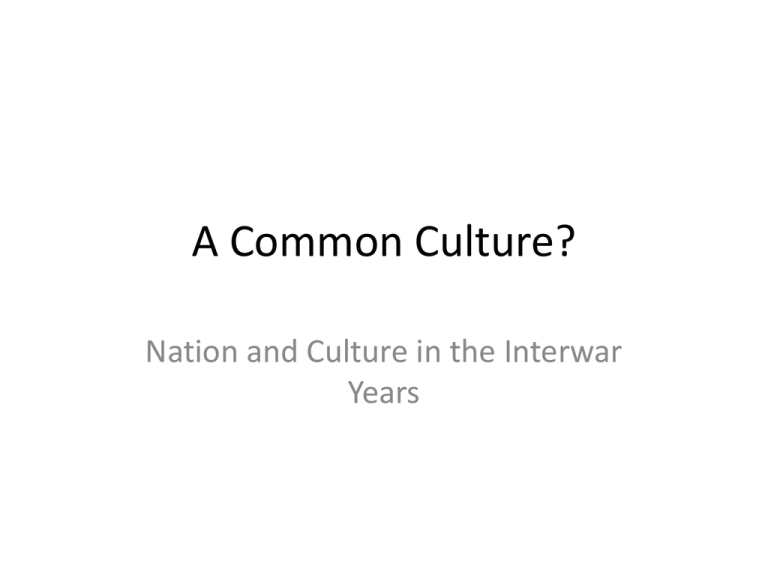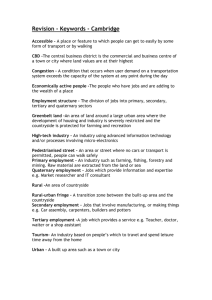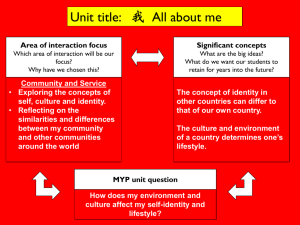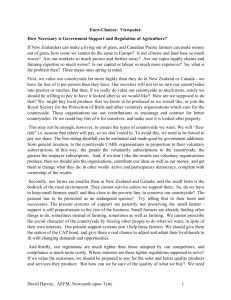A Common Culture? Nation and Culture in the Interwar Years
advertisement

A Common Culture? Nation and Culture in the Interwar Years • 1. Introductory thoughts • 2. The countryside and a common culture • 3. New media, a common culture, and a culture for democracy Question(s) • To what extent did the period between the First and Second World War see the emergence of a common culture? • What do we mean by a ‘common culture’? • If there was a common culture, what were the causes and factors lying behind this? • What were the factors that cut across and undermined a common culture? • Why have historians been interested in the existence of a common culture? Why the Question? i) Paradox: Inequality and Social Division Stability and Conservatism Why the Question: ii) Declinism English Culture and the Decline of the Industrial Spirit (Martin Weiner, 1981) The Uses of Literacy (Richard Hoggart, 1957)/Americanisation Why the Question: iii) social change The three Englands of J.B. Priestley (1934) Old England Industrial England The new England: Americanisation 2. THE COUNTRYSIDE AND A COMMON CULTURE? Wiener’s Decline of the Industrial Spirit/Rural Nostalgia/Backwardness Lines of argument • Britain the first industrial nation, but middle-class fail to invest in industry • Seductions of the values of the landed, aristocratic elite • Hostility to the two other Englands • Role of public schools and national culture spread the anti-industrial spirit Problems • Gentlemanly capitalism also a story of landed classes being seduced (and success) • Embrace of the countryside may in fact be a logical outcome of being the first industrial and urban society: a sign of modernity not backwardness. • Other of eg Germany also romantices countryside The Comfort of the Countryside Nostalgia • 80% of population urban by 1900. Preservationism • Council for the Preservation of Rural England founded in 1926 Political mobilisation • • • • Stanley Baldwin, 1924 Iron and Steel family background Interwar dominance of Conservative Party Attractions of salve of country vision of nation in times of strife? Hiding from realities of social problems; needs for rearmanent? Success of interwar conservatism founded on mobilisation of ideas of their representation of a ‘public’ against (class) sectionalism. Value of countryside rhetoric in appealing above class as the national party (era of National Governments in wartime and economic crises). • To me, England is the country, and the country is England. And when I ask myself what I mean by England when I am abroad, England comes to me through my various senses — through the ear, through the eye and through certain imperishable scents ... The sounds of England, the tinkle of the hammer on the anvil in the country smithy, the corncrake on a dewy morning, the sound of the scythe against the whetstone, and the sight of a plough team coming over the brow of a hill, the sight that has been seen in England since England was a land ... the one eternal sight of England. Modernity and the Embrace of the Countryside • • • • • • Disenchantment (Weber): Reenchantment via eg folk lore movement/invention of tradition (Trentmann) British style of modernism Historical critiques of Industrial Rev Conservationism and roots of ecology and environmentalism Road to state management of resources: national parks, green belts, new towns, garden suburbs … (Matless) Embrace of countryside made possible and democratised by modern technology: bicycles, cars, trains. Radical politics of land access. Also new leisure time/wealth: Blackpool … Modernity and the Landscape So … • Series of reasons for importance of countryside • Not just a symbol of backwardness • Reasons could differ across class; meaning complex • But also links across class; elements of a common culture; factors of nationalisation of politics, pressure groups, technology, increased leisure, role of the state underlie this linkage across class (perhaps also that countryside depoliticised) 3. NEW MEDIA, A COMMON CULTURE, AND A CULTURE FOR DEMOCRACY Radio and the BBC • 1939: 9m licences in population of 48m • Creation of a new nation landscape, reaching into living rooms • Elevating ‘Reithian’ agenda of a culture for democracy (John Reith, first Director General of BBC 1927-38) • Persistence of Victorian values at heart of common culture? (Jonathan Rose, The Intellectual Life of the British Working Classes The Press • National popular press (Adrian Bingham) • Sport (divides but also unites: peak of attendance in aftermath of WWII) • Human interest (aristocrat’s son; women’s issues) • Interchange of media forms (also via eg BBC) • A culture for democracy (in terms of class but also gender)? Cinema • The appeal of the ‘dream palace’ (escapism) • Attendance: 18-19m attendances/year by 1930s; peak 30m in 1945 • National boundaries, quotas, and Americanisation (also dance and music): preference for democratic style of American culture Or a more class-defined and therefore divided society? • BBC an instrument of paternalism and not politically neutral (General Strike): a culture FOR democracy – paternalism of Reith Role of culture (and nationalisation of media in the making & dividing of classes) Snobbery, elitism, and Intellectual attacks on mass culture • Modernism deliberately distances itself from mass culture, but also criticises suburbia and ‘middlebrow’ • Middle-class suspicion of cinema and America • Even on the left, Priestley worried about England ‘Blackpooling itself’ So … • Are the (powerful) forces behind the nationalisation of culture between the wars creating or exposing the division of a ‘common culture’? • Looked at from the perspective of the 21st century, is this period marked out by the degree to which there was a powerful national culture, and if so why? • Is a common culture an important element in explaining the balance of social division and stability in the period?





